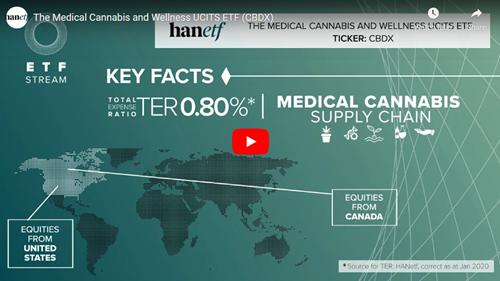What every investor needs to know about the Medical Cannabis sector in 2021


Nawan Butt, Portfolio Manager of The Medical Cannabis and Wellness UCITS ETF (CBDX)
2020 was an eventful year for the cannabis industry. After a strong start to the year, the coronavirus struck. Panicked investors withdrew from equities, especially from young and riskier industries such as cannabis.
This did not deter the medical cannabis from having a great run in 2020 with a return of over 40%[1]. Past performance is no guarantee of future performance. This upside has mostly been reflected through the proliferation of cannabis in the United States.
With President Joe Biden now at the helm, there is an improved outlook for the cannabis sector under a Democratic House and Presidency as well as a surprise Blue Senate. Political power in the US is in Democratic hands and the path is now clear for further cannabis reform in the US.
Stock prices have reacted accordingly, rising to year end-highs. Is the cannabis industry now set to flourish?
[1] Source: Medical Cannabis and Wellness Equity Index (NTR) 40.41% as of 30.12.2020
The promise of cannabis reform brings a new cycle of growth to the sector
The outcome of the US election provides fertile ground for the further expansion of the medical cannabis sector. As early as November 2020, before it was known that Senate would also be in Democratic hands, five new states in the US decided to legalize a mix of adult use or medical cannabis.
Of particular significance is the legalization of cannabis for adult use in New Jersey which is causing a domino effect in its neighboring states on the densely populated east coast. The majority of Democrats in the House and Senate means that cannabis reforms now have a much better chance of asserting themselves nationwide.
Medical cannabis deemed ‘essential’
The authorities in Canada and the USA have recognized the importance of the medical cannabis sector and deemed these companies as ‘essential’, so that they could continue their business operations despite lockdowns during the Pandemic. This is the first time that the importance of the sector had been highlighted by the state and clear signal to the market that the industry has developed a long-term raison d'etre.
Growth is progressing worldwide
Within Europe and the UK, we are seeing multiple jurisdictions adopt a legalization framework and expect the rate of cannabis reform to accelerate on a global scale as medical cannabis becomes comes more accepted.
The speed of such developments is often influenced by what is happening in the US and again highlights the importance of the current US election results for the cannabis sector worldwide. We expect that the US will provide regulatory precedence for many countries over the world and there is still a significant addressable market yet to come online.
Germany reached a symbolic milestone in September. Since the start of the medical cannabis program in early 2017, more than 100,000 patients have applied for reimbursement from their insurance companies.
Although this figure is not all-encompassing, it provides an insight into the growth of the medical cannabis program in Germany, which has grown steadily since its introduction. Total refunds amounted to EUR 36.7 million in the second quarter of 2020. As a result, Germany achieved sales of around EUR 150 million and an increase in sales of 24% compared to the previous year
The number of patients who have been approved for medical cannabis treatment also continued to rise in Australia and Israel. Australia recorded a further 6,000 patients in January 2021 and another 5630 in August. Similar developments are also playing out in in other countries.
The London Stock Exchange (LSE) is expecting to have medical cannabis listings as early as the first half of 2021 which means that many Brits could soon be holding cannabis in their retirement portfolios.
Will the rally last this time?
Some investors are still skeptical. The first wave of cannabis in 2018-19 came just as quickly as it disappeared. Will history repeat itself?
We believe that this time the price increase is on a more solid footing, being driven by the drastic change of power in the United States and the introduction of a new investor class into this theme, the US institution.
In 2018, valuations rose due to expected growth after legalization in Canada. This time, however, it is about the US, the world's largest consumer market. The addressable market in the US is estimated to be approximately seven to ten times greater.
This immediate opportunity has current implied growth rates around 25% for the next five years and if the earnings continue to materialize, valuations may continue to catch up to the rest of the market[2].
[2] Source: Purpose Investments
Direct investment or Medical cannabis ETF?
Investors have a choice between direct investments in cannabis stocks and a medical cannabis ETF. As cannabis is a regulated substance, investors must be careful that an investment does not violate local laws, even if the stocks themselves are perfectly legal to trade in Canada and the US.
An ETF is a basket of stocks that tracks the performance of an index such as the Medical Cannabis and Equity Index. ETFs trade on a stock exchange and can be bought in the same way as a share through a broker.
It is an accessible way to buy into a theme without having to pick individual stocks, provides diversification and the provider will have done the due diligence to ensure that the ETF is legal in the country it is registered in. Of course, like shares, ETF prices can go down as well as up and an investor’s capital is at risk.
To buy this trust login to your EQi account
The Medical Cannabis and Wellness UCITS ETF (CBDX) - IE00BG5J1M21
Important Information
The content in this document is issued by HANetf Limited (“HANetf”), an appointed representative of Mirabella Advisers LLP, which is authorised and regulated by the Financial Conduct Authority (“FCA”). For professional clients only. Past performance is not a reliable indicator of future performance. Any historical performance included on this document may be based on back testing. Back testing is the process of evaluating an investment strategy by applying it to historical data to simulate what the performance of such strategy would have been. Back tested performance is purely hypothetical and is provided on this document solely for informational purposes. Back tested data does not represent actual performance and should not be interpreted as an indication of actual or future performance. The value of any investment may be affected by exchange rate movements.
Any decision to invest should be based on the information contained in the appropriate prospectus and after seeking independent investment, tax and legal advice. These products may not be available in your market or suitable for you. The content of this document does not constitute investment advice nor an offer for sale nor a solicitation of an offer to buy any product or make any investment. An investment in an ETF is dependent on the performance of the underlying index, less costs, but it is not expected to match that performance precisely. ETFs involve numerous risks including among others, general market risks relating to the relevant underlying index, exchange rate risks, interest rate risks, inflationary risks, liquidity risks and legal and regulatory risks.
The information contained on this document is not, and under no circumstances is to be construed as, an advertisement or any other step in furtherance of a public offering of shares in the United States or any province or territory thereof, where none of the Issuers or their products are authorised or registered for distribution and where no prospectus of any of the Issuers has been filed with any securities commission or regulatory authority. No document or information on this document should be taken, transmitted or distributed (directly or indirectly) into the United States. None of the Issuers, nor any securities issued by them, have been or will be registered under the United States Securities Act of 1933 or the Investment Company Act of 1940 or qualified under any applicable state securities statutes. The products discussed on this document are issued by HANetf ICAV.
This document may contain forward looking statements including statements regarding our belief or current expectations with regards to the performance of certain assets classes and/or sectors. Forward looking statements are subject to certain risks, uncertainties and assumptions. There can be no assurance that such statements will be accurate and actual results could differ materially from those anticipated in such statements. Therefore, readers are cautioned not to place undue reliance on these forward-looking statements. HANetf ICAV is an open-ended Irish collective asset management vehicle which is constituted as an umbrella fund with segregated liability between sub-funds and with variable capital organised under the laws of Ireland and authorised by the Central Bank of Ireland (“CBI”). Investors should read the prospectus of HANetf ICAV (“HANetf Prospectus”) before investing and should refer to the section of the HANetf Prospectus entitled ‘Risk Factors’ for further details of risks associated with an investment in the Shares.
Click to visit
Read the latest edition of DIY Investor Magazine
DIY Investor Magazine
The views and opinions expressed by the author, DIY Investor Magazine or associated third parties may not necessarily represent views expressed or reflected by EQi.
The content in DIY Investor Magazine is non-partisan and we receive no commissions or incentives from anything featured in the magazine.
The value of investments can fall as well as rise and any income from them is not guaranteed and you may get back less than you invested. Past performance is not a guide to future performance.
DIY Investor Magazine delivers education and information, it does not offer advice. Copyright© DIY Investor (2016) Ltd, Registered in England and Wales. No. 9978366 Registered office: Mill Barn, Mill Lane, Chiddingstone, Kent TN8 7AA.


